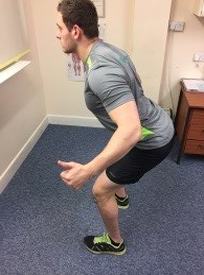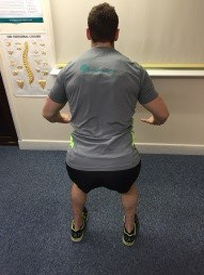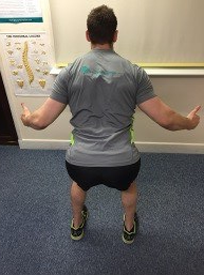Iliotibial Band Friction Syndrome (ITBFS)
Cyclists will develop pain on the outside aspect of their knee around the knee cap and over the joint line, caused by a Friction effect of the Iliotibial Band (a strong connective tissue) rubbing the Bursal structures (small fluid filled sacs) that sit between the Iliotibial Band and the Bone. This is caused by the knee being at the wrong angle - it needs to be in no less than 23° of knee flexion at bottom dead centre (pedal position). At YourPhysioPlan.com we would measure your joint position and adjust your seat height and cleat position, to ensure this angle is avoided, with most riders finding it most comfortable to have their cleat rotated to a natural toe out position, normally with their heal just clipping the crank on each pedal stroke.
Lower Back Pain
Cyclists are prone to Mechanical Low Back Pain due to the nature of a sustained flexed posture while cycling, placing pressure on the front of the spinal discs, and keeping posterior sacral ligaments in a lengthened position. This can be avoided by adjusting the inclination of the seat, with an anterior tilt of between 10°-15° having been shown to reduce low back pain in cyclists. This Mechanical form of back pain can be identified early by a YourPhysioPlan.com physiotherapist, and along with changes to your bike set up, it is possible to design pre-hab and re-hab plans to prevent this becoming an acute or chronic issue. Many cyclists may implement a ‘hamstring drag’ during their pedal stroke, but it has been shown that being more Gluteal dominant during the drive phase is more effective for performance and injury prevention. YourPhysioPlan.com physiotherapists will be able to work on ensuring your performance is enhanced by focusing on these muscle groups.
Thoracic (Mid-Back) and Scapula (Shoulder Blade) Pain:
The ‘On-Bike’ posture of the shoulder and hips being at 90° in relation to the trunk causes postural fatigue through the Thoracic (Mid-Back) region as sustaining this posture requires both flexibility and stability. In order for the Cyclist to produce power in this position they are required to be able to dissociate their hips while maintaining a stable core through pelvis and trunk. YourPhysioPlan.com Physiotherapists can aid this with core stability training and scapular strengthening exercise to prevent neck and mid-back pain, while helping to maximise performance by producing a strong trunk to drive the hips from.
Stretches
The following stretches should be performed 3-5 times per week as a preventative measure as cycling will cause adaptive changes to these structures, which can be reversed / prevented with regular stretching.
Piriformis
Start in a press up position, and then pass one leg diagonally underneath you. Rest your weight down onto your elbows and down through the knee under your stomach, trying to get as flat to the floor as you can. You should feel the stretch deep inside the Gluteal region of your bent leg. Hold this for 30 seconds and repeat 3 times.
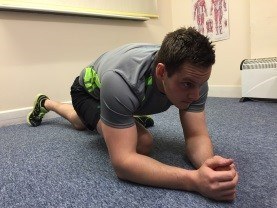
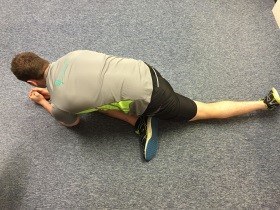
Hamstrings
It is possible to stretch your hamstrings in several positons, but seated will allow you to progress to standing positions, as cyclist’s hamstrings are generally shortened due to riding postures.
Sitting on the floor, keep one leg straight (which will be stretched) and bend the other up to your chest (for stability). Keeping the knee of your straight leg locked out reach as far down you shin towards your toes as you can and hold. Hold this for 30 seconds and repeat 3 times.
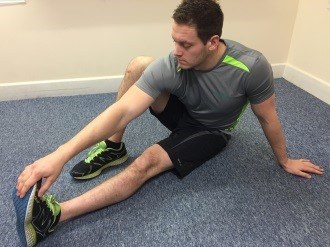
Lumber Spine Rolls
It is important to stretch your lower back to minimise the mechanical lower back pain brought about through cycling postures.
Laying flat on your back bring one leg over by rotating your hips, while keeping your shoulders flat on the floor. Pull this leg towards your shoulder with your arm, and hold the stretch for 30 seconds, repeating this 3 times on either leg.
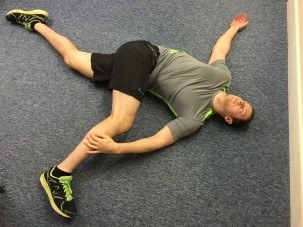

Iliotibial Band (ITB):
Maintaining the length of the ITB can help reduce the friction around the knee while cycling.
Stand with your weight on one leg, while passing the other leg behind and across your midline. With the same arm take it above and over your head. Hold the stretch for 30 seconds and repeat 3 times on either side.


Activation Exercises
The following activation exercises are to be done before any land based, gym based or bike based training or race situation. This will produce increased blood flow and flexibility giving more efficient muscle activity helping to reduce the risk of injury and increase performance.
Gluteals
Kneeling on all 4’s, push heal up towards the ceiling, keeping your hips square and your back flat, pausing for 2-3 seconds at the top of the movement. Slowly lower your knee back to the ground and repeat the movement. Perform this 10 times on each leg.
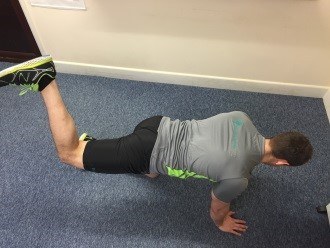
Hamstrings
Laying on your front dynamically flick your leg from one side over the other, lifting your foot towards the opposite shoulder. Return your leg to the starting position and repeat the movement with the other leg. Complete 10 repetitions on either leg.
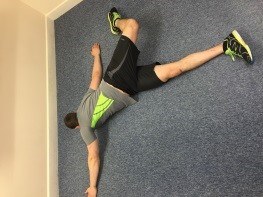
Laying with your back flat on the floor, keep one leg straight, and the other to be held at 45º by a partner. Gently push your heal into your partners hands with 5-10% of your strength, while your partner pushes it away from them, back towards your head. Once your leg has been pushed away use your hamstrings and gluteals to ‘throw’ it back into your partner’s hands. Repeat 10 times on each leg.

Quads
Squat – with your feet shoulder width apart and your feet slightly turned out sit your hips back as if you are sitting back onto a bench, gliding your knees over your toes. Aim to weight bear through your heels, helping to activate your Gluteals, ready to fire your Quads in order to return you to a standing position. Slowly lower yourself again and repeat 10 times.
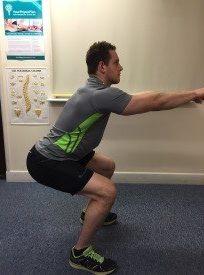
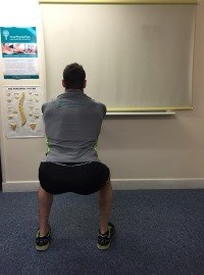
Scapula
Sit into a half squat position with your elbows in line with your ribs. Keeping your elbows still, pull your shoulder blades back and together. Hold for 5 seconds and repeat 10 times.
